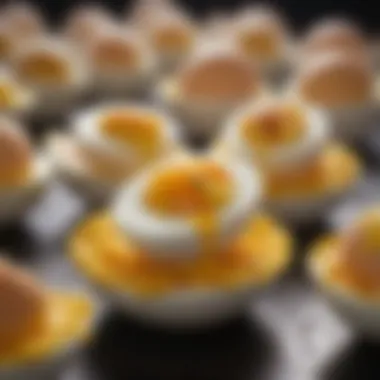Mastering the Art of Cooking Perfect Hardboiled Eggs


Recipe Overview
Cooking hardboiled eggs may seem simple, but mastering it involves understanding various techniques and potential challenges. This section will provide a brief overview of the recipe while highlighting the key ingredients and tools needed.
Brief Summary of the Recipe
Hardboiled eggs are versatile and can be used in various dishes or enjoyed on their own. The simple act of boiling an egg can yield different results depending on multiple factors such as boiling time, egg size, and freshness. The goal is to achieve the ideal texture and doneness that align with personal preferences.
Key Ingredients and Tools Needed
- Fresh Eggs: The main component, with age influencing freshness and ease of peeling.
- Pot or Saucepan: A reliable pot to hold the eggs while boiling.
- Water: Enough to cover the eggs during cooking.
- Ice Bath: For cooling the eggs after boiling to make peeling easier.
Step-by-Step Instructions
Preparing hardboiled eggs requires careful attention to each step. Here is a detailed guide to ensure successful cooking.
Detailed Cooking Steps
- Place the Eggs in the Pot: Gently add the fresh eggs to the pot, ensuring they are not overcrowded.
- Add Cold Water: Pour enough cold water into the pot to cover the eggs by about an inch.
- Bring to a Boil: Heat the pot over medium-high heat until the water reaches a rolling boil.
- Cover and Remove from Heat: Once boiling, cover the pot with a lid and remove it from heat. Allow the eggs to sit for 9 to 12 minutes, depending on the desired doneness.
- Prepare the Ice Bath: While the eggs sit, prepare a bowl of ice water. This will help stop the cooking process.
- Transfer Eggs to Ice Bath: After the time is up, carefully transfer the eggs to the ice bath and let them cool for at least 5 minutes.
- Peel the Eggs: Tap the eggs gently on the counter to crack the shell and peel under running water, if necessary.
Tips for Successful Execution
- Use older eggs for easier peeling; fresh eggs tend to have a harder shell.
- Adjust your boiling time based on egg size and preferred doneness. Smaller eggs may need less time, while larger ones might need more.
- Always cool the eggs promptly in an ice bath to prevent overcooking and resulting in a greenish yolk.
"Perfectly cooked hardboiled eggs should have a creamy yolk without any green ring around it."
By following these instructions, anyone can achieve perfect hardboiled eggs, enhancing various meals with this simple yet essential protein.
Preamble to Hardboiled Eggs
Hardboiled eggs stand as a simple yet profoundly versatile food that features prominently in many culinary traditions around the world. Understanding these eggs can significantly enhance both the skill of the cook and the flavors of the dishes he or she prepares. This section delves into the definition, characteristics, and nutritional aspects of hardboiled eggs, offering insights that extend beyond mere cooking techniques.
Definition and Characteristics
Hardboiled eggs are prepared by cooking eggs in their shells in boiling water until the yolk and white are entirely set. This cooking method allows for the transformation of the egg's proteins, making the contents firm while maintaining a creamy texture in the yolk. The key characteristics of hardboiled eggs include the firmly cooked yolk which ranges in color from pale yellow to bright orange, depending on the hen's diet. Furthermore, hardboiled eggs have a slightly resilient shell which protects them during the cooking process. The method of cooking impacts factors such as texture, flavor, and the likelihood of developing that unappealing dark ring around the yolk.
Nutritional Value
Hardboiled eggs are a powerhouse of nutrition. Each egg provides essential nutrients that are significant for a balanced diet. They contain high-quality protein, vitamins, and minerals. Specifically, one hardboiled egg typically includes:
- Protein: Around 6 grams, aiding muscle repair and growth.
- Vitamin B12: Crucial for nerve function and the production of DNA and red blood cells.
- Vitamin D: Important for calcium absorption, supporting bone health.
- Selenium: An antioxidant that helps combat oxidative stress in the body.
Additionally, hardboiled eggs are low in calories, making them a satiating snack or component in meals without excessive caloric intake. Their composition allows for a balanced consumption, as they contain healthy fats while being free of carbohydrates, making them suitable for various dietary preferences.
It is important to consider the method of preparation, as overcooking can lead to undesirable changes in taste and appearance. Properly cooked hardboiled eggs can be a nutritious addition to salads, snacks, and breakfast dishes, showcasing their adaptability across numerous culinary applications.
"Mastering the technique of cooking hardboiled eggs not only elevates your personal cooking skills but enriches the experience of enjoying a multifaceted ingredient."
Overall, understanding the characteristics and nutritional value of hardboiled eggs sets the groundwork for mastering their preparation and incorporation into various meals.
Essential Ingredients and Equipment
Understanding the essential ingredients and equipment for cooking hardboiled eggs is key to mastering this skill. Each component plays a significant role in ensuring that the eggs are cooked properly and yield the best results. Choosing the right eggs and utilizing suitable cooking tools can greatly enhance the cooking process, leading to consistent outcomes.


Selecting the Right Eggs
Choosing high-quality eggs is crucial. Fresh eggs often yield better results, providing firmer whites and richer yolks. Look for eggs labeled as free-range or organic if possible. These eggs tend to have a better flavor and texture.
- Freshness: Check the pack date; the fresher, the better.
- Size: Large eggs are standard for most recipes, but understanding size differentials can help if you are adjusting cooking times.
- Quality: Eggs from local farms can be superior in taste and freshness compared to mass-produced options.
Required Cooking Equipment
Effective cooking of hardboiled eggs necessitates specific equipment. Each tool aids in streamlining the cooking process while improving outcomes.
Saucepan
A sturdy saucepan is vital. It serves as the primary cooking vessel for boiling the eggs. Its size should be large enough to accommodate the number of eggs you wish to cook, with enough water to cover them.
- Material: Preferably stainless steel or non-stick, as these materials provide even heat distribution.
- Key Feature: A lid is essential; keeping it on while boiling helps maintain heat and decreases cooking time.
- Advantages: A good saucepan ensures consistent temperature, preventing under or overcooking. Without a lid, heat escapes and can lead to unpredictability in cooking times.
Timer
A timer is indispensable. Timing is crucial to achieving the desired yolk consistency. Overcooking can lead to an unattractive green ring around the yolk and affect taste.
- Key Characteristic: Accurate timing; modern timers often come with multiple functions.
- Unique Feature: Digital timers can often be programmed for various recipes, enhancing versatility.
- Advantages: It prevents guesswork, allowing for precision in cooking. Timers can even help in managing multiple dishes at once, which is particularly useful during meal prep.
Ice Bath Container
An ice bath container is a useful addition. This tool facilitates rapid cooling after cooking, which is critical for peeling and improving texture.
- Key Characteristic: Sized appropriately to hold enough ice and water to fully submerge the eggs.
- Unique Feature: Can also be used for other culinary tasks, like chilling vegetables or setting gelatin.
- Advantages: Quickly halting the cooking process helps prevent overcooking. Eggs that are cooled immediately are easier to peel, which ultimately reduces frustration in the kitchen.
Using the right tools and ingredients ensures successful cooking, ultimately elevating the simple hardboiled egg to a delightful delicacy.
Fundamental Cooking Methods
When discussing how to achieve golden results when cooking hardboiled eggs, the choice of method can greatly influence the final product. Various techniques have their own set of advantages, allowing cooks to select a method that best fits their preferences, equipment, and time constraints. Understanding these fundamental cooking methods will lead to not only better eggs but also a more efficient cooking experience.
Stovetop Method
The stovetop method is one of the most common ways to cook hardboiled eggs. This method involves boiling the eggs directly in water on a stoved stove. It is straightforward and allows for great control over the cooking conditions.
Steps for the Stovetop Method:
- Start with a saucepan and add cold water, enough to cover your eggs by about an inch.
- Insert the eggs gently to avoid cracks.
- Turn the heat to medium-high until the water reaches a rolling boil.
- Once boiling, remove the pan from heat and cover it with a lid.
- Let the eggs sit for a specific time; typically, 9 to 12 minutes depending on desired firmness.
- After resting, place the eggs in an ice bath immediately. This helps stop the cooking process.
This method is beneficial because it allows for immediate visual monitoring. Cooks can adjust timings based on their specific taste for doneness. It also remains economical, requiring minimal equipment.
Oven-Baked Method
The oven-baked method is less traditional but offers a unique advantage, especially for larger batches. This method exploits the consistent heat distribution of the oven to cook eggs gently.
Steps for the Oven-Baked Method:
- Preheat the oven to 325°F (about 160°C).
- Place the eggs in a muffin tin to prevent them from rolling.
- Bake for approximately 25-30 minutes.
- Once time is up, transfer the eggs to a bowl of ice water.
Using the oven allows for cooking multiple eggs at once without the need for additional pots or water. It reduces the risk of cracking overly delicate shells and ensures even cooking. However, monitoring time is critical to avoid overcooking.
Instant Pot Method


The Instant Pot method is a contemporary approach favored for its speed and reliability. The pressure cooking environment significantly reduces cooking times.
Steps for the Instant Pot Method:
- Add one cup of water to the Instant Pot along with the steamer basket.
- Place the eggs on the steamer basket.
- Seal the lid and set to pressure cook for 5-7 minutes.
- Use the natural release for about 5 minutes then transfer to an ice bath.
This method is particularly useful for those pressed for time. The Instant Pot guarantees perfectly cooked eggs with minimal oversight. It’s convenient for batch cooking and reduces the likelihood of human error in time management.
Each method has its unique benefits. Choose based on your personal needs to master cooking hardboiled eggs efficiently.
Detailed Step-by-Step Instructions
The section on Detailed Step-by-Step Instructions is crucial in this article as it lays a systematic framework for achieving perfectly cooked hardboiled eggs. It is not just about cooking; it’s about mastering the nuances and nuances involved in the process. Following a methodical approach increases the chances of success regardless of skill level. By diving into specifics, readers can avoid common pitfalls, ensuring that each egg is properly prepared and results in a desirable finished product.
Preparing the Eggs
The very first step in preparing hardboiled eggs is selecting the right eggs. Fresh eggs can be more challenging to peel compared to slightly older eggs. It is advisable to utilize eggs that have been in the refrigerator for about a week, as they usually offer a better peeling experience. Once chosen, inspect the eggs for any cracks or abnormalities. Cracked eggs should be set aside to avoid problems during the cooking process. When preparing, cleanse the shells gently under cold water to remove any dirt or debris. This preparation is essential because maintaining cleanliness limits the risk of contaminants, promoting a healthier end product after cooking.
Cooking Process
Cooking is where precision matters most. Proper timing and temperature control form the backbone of a successful boiling technique.
Time Management
Time management plays a vital role in the cooking of hardboiled eggs. The general guideline is to boil eggs for about 9 to 12 minutes depending on the size and desired doneness. Here, the key characteristic of time management is alignment with desired outcomes. Those who prefer softer yolks might choose the shorter time at around 9 minutes, while individuals who favor firmer yolks can extend the time to about 12 minutes. The unique feature of this aspect is how precise timing can greatly influence the final result. Misjudging the time may result in undercooked or overcooked eggs, both of which can be unsatisfactory. Therefore, using a timer when boiling eggs is highly recommended, allowing the cook to focus on other tasks without losing track of their hardboiled eggs.
Temperature Control
Temperature control is another critical component when cooking hardboiled eggs. It involves ensuring that the water reaches a rolling boil before adding the eggs, followed by monitoring the heat to avoid overflow or rapid boiling. The primary advantage of effective temperature management is achieving a consistent cooking state. An inherent feature of this control method is its ability to prevent uneven cooking, thus allowing for a smooth, desired texture. Consistency is key when striving for the perfect hardboiled egg. If the water's temperature fluctuates too much during cooking, it may lead to an undesirable outcome, affecting taste and texture. Steady, manageable temperatures create a more predictable environment for the eggs to cook uniformly.
Cooling and Peeling Method
Once the eggs are cooked, cooling them promptly is essential. An ice bath is the most efficient way to halt the cooking process immediately. It also helps in reducing the chances of overcooking. Submerge the cooked eggs in a bowl filled with ice and cold water for several minutes. This method helps in achieving easier peeling.
After the cooling period, peeling becomes the next task. Cracking the shell gently on a hard surface and rolling it slightly can ease the process. Starting at the wider end where the air pocket is found often leads to better peeling. Taking care during this step can turn a potentially frustrating experience into a satisfied one, laying the groundwork for successful dishes to follow.
Common Problems and Solutions
Understanding common problems and their solutions in the context of cooking hardboiled eggs is essential for achieving optimal results. Every cook may face challenges, and being prepared to tackle these issues can lead to better cooking experiences. Addressing problems such as cracked shells, inconsistency in doneness, and difficulties in peeling not only enhances the quality of the final product but also builds confidence in your cooking skills. An informed approach can transform routine cooking into a gratifying endeavor.
Cracked Shells
Cracked shells can occur for various reasons. Often, it happens when eggs are added to boiling water too quickly, leading to thermal shock. To minimize this risk, gently place eggs in the water rather than dropping them in, and consider bringing water to a boil first followed by lowering the temperature. Additionally, using older eggs can help. Fresh eggs tend to be more difficult to peel due to the lower pH level of the egg white, which causes it to adhere more firmly to the shell. To mitigate cracked shells:
- Use eggs that are at room temperature to reduce shock when placed in hot water.
- Start with cold water and bring it to a boil along with the eggs.
- Avoid high temperatures. Once boiling, consider lowering the heat to maintain a gentle simmer instead of a rolling boil.
Under or Overcooked Eggs
Achieving the perfect cooking time is crucial for the desired level of doneness. Under or overcooked eggs lead to undesirable textures and flavors, diminishing the overall experience. Factors such as egg size, initial temperature, and altitude can influence cooking time. The general recommened cooking times vary:
- Soft-boiled: 6-7 minutes for a creamy yolk.
- Medium-boiled: 8-9 minutes for a creamy but firmer yolk.
- Hard-boiled: 10-12 minutes for a fully set yolk.
To mitigate the risk of undercooking or overcooking, pay attention to these strategies:


- Use a reliable timer. Don't rely solely on visual cues, as times may vary.
- Consider your stove's heat output. If you notice differences in cooking times, adjust accordingly.
- Test for doneness. If uncertain, you might try one egg to gauge the results before cooking the rest.
Difficulty in Peeling
Peeling hardboiled eggs can be frustrating, particularly when the egg white clings stubbornly to the shell. This is typically a result of fresh eggs, which can be more challenging to peel. Here are several recommendations to ease peeling:
- Cold shock: After cooking, immediately place the eggs in an ice bath. This step causes the egg to contract slightly, making peeling easier.
- Roll gently: Once cooled, roll the egg on a hard surface to create cracks in the shell before peeling.
- Use the right technique: Start peeling from the wider end of the egg, where there is usually an air pocket, making it easier to begin.
As you consider these common problems, remember that practice will increase your mastery over cooking hardboiled eggs. Regular experimentation will foster confidence and skill.
Creative Uses for Hardboiled Eggs
Hardboiled eggs extend beyond just a simple dish. Their versatility allows them to be included in various meals and snacks, making them an essential item in many kitchens. Various cultures and culinary practices embrace hardboiled eggs in different ways. Incorporating them not only adds texture and flavor to dishes but also enhances nutritional value. Let’s explore some creative and practical applications.
In Salads and Wraps
Adding hardboiled eggs to salads is a common practice. Sliced or chopped eggs can boost the protein content, making salads more filling. Whether mixed into a classic Caesar salad or atop a garden salad, they provide both flavor and nutrition.
Depending on personal preference, you can use different types of dressings. A tangy vinaigrette pairs well with the smooth texture of the egg, while a creamy dressing like ranch enhances it in richer salads. Wraps can also benefit; adding slices of hardboiled eggs creates a satisfying meal. Avocado, lettuce, and a sprinkle of seasonings with hardboiled eggs give a delightful contrast of flavors.
As Snacks and Appetizers
Hardboiled eggs serve as an excellent snack. They are portable and easy to prepare ahead of time. Simply boiling and cooling them can set the stage for various garnishes or dips. A light dusting of salt or paprika is simple yet enhances the taste significantly.
For an appetizer, deviled eggs are a popular choice. The recipe is flexible, allowing for creativity in flavoring. Depending on the ingredients, you can make them classic or give them a modern twist with unexpected additions like sriracha or avocados.
Hardboiled eggs make for an excellent snack that is both convenient and nutritious.
In Breakfast Dishes
Incorporating hardboiled eggs into breakfast can add a protein boost. Sliced eggs can be placed on toast or served alongside oatmeal to create a balanced morning meal. Additionally, egg salad sandwiches are a wonderful option for an easy breakfast on the go.
Using hardboiled eggs in breakfast bowls can be delightful too. Mixing the eggs with quinoa, greens, and nuts provides variety and nutrition. This versatility makes hardboiled eggs an important component in breakfast menus.
Culmination
In any culinary journey, understanding the ingredients and techniques is critical. Hardboiled eggs serve as a prime example of simple food preparation that can lead to a multitude of possibilities. The versatility of hardboiled eggs is commendable; they can enhance a variety of dishes ranging from salads to breakfast options. This article has outlined numerous methods to cook them, addressed common issues, and proposed creative usages.
The importance of mastering hardboiled eggs lies in their nutritional value and culinary adaptability. They provide a high-quality protein source and essential nutrients that can contribute positively to various diets. Learning to cook them properly means you can trust their integration into countless recipes.
The Versatility of Hardboiled Eggs
Hardboiled eggs are not merely a stand-alone item. They can found in many cuisines around the world. For instance, in Japanese cuisine, the ajitsuke tamago is a soy sauce-marinated egg. Similarly, in various Mediterranean dishes, eggs often accompany grains and vegetables, creating a well-rounded profile. The unique texture and smooth flavor of perfectly cooked eggs can add depth to meals.
Consider these options for incorporating hardboiled eggs:
- Salads: Chop them into green salads or mix them with mayonnaise for a classic egg salad.
- Snacks: Sprinkle some salt and pepper on a chilled egg for a quick protein-rich snack.
- Garnishes: Use sliced eggs as a garnish on soups or as part of a charcuterie board.
The ability to adapt hardboiled eggs to one's preferences makes them an essential component in meal preparation.
Encouragement for Experimentation
Cooking should be an explorative process. Hardboiled eggs, while deceptively simple, are an excellent canvas for creativity in the kitchen. Don’t hesitate to experiment with flavors and presentation.
Consider trying these approaches:
- Spices & Herbs: Add smoked paprika, curry powder, or fresh herbs to the eggs for an unexpected twist on flavor.
- Pickling: Try pickling cooked eggs in a vinegar solution to create a tangy addition to your meals.
- Stuffing: Develop stuffed egg recipes by adding yolk mixtures to the cooked whites, creating bite-sized treats.
Every effort towards experimentation will yield insights into cooking techniques and flavor pairings. The only boundary is one's creativity.
Embracing the versatility of hardboiled eggs while experimenting can ignite your culinary passion and enhance your cooking skills.







